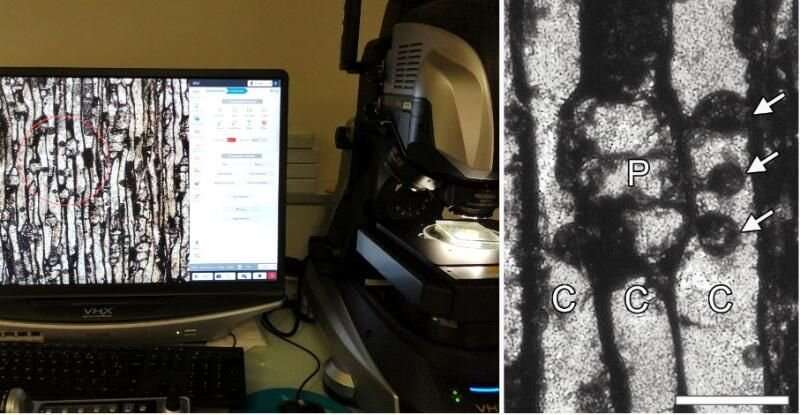This article has been reviewed according to Science X's editorial process and policies. Editors have highlighted the following attributes while ensuring the content's credibility:
fact-checked
peer-reviewed publication
trusted source
proofread
360-million-year-old Irish fossil provides oldest evidence of plant self-defense in wood

Plants can protect their wood from infection and water loss by forming special structures called "tyloses." These prevent bacterial and fungal pathogens from getting into the heartwood of living trees and damaging it. How early in the evolution of plants the woody species became capable of forming such defenses was not previously known.
Published today in Nature Plants is the oldest evidence of tylosis formation from Late Devonian (360-million-year-old) fossil wood from the Hook Head Peninsula area, Co. Wexford, Ireland.
These plants lived well before the time of the dinosaurs or even flying insects. They formed the first primeval forests, when plants ruled the continents, accompanied by microorganisms, fungi, and early relatives of spiders, millipedes and centipedes.
Dr. Harper and her team, including Dr. Anne-Laure Decombeix (CNRS, France), Dr. Cyrille Prestianni (Uni. Liège, Belgium), Trinity Botany Ph.D. student Thibault Durieux (co-advised by Harper and Decombeix), Merlin Ramel (INRAe, France), and Prof Michael Krings (BSGP, Munich, Germany and Trinity SNS Visiting Research Associate), discovered tyloses in the fossilized wood of an extinct group of plants known as the Archaeopteridalean progymnosperms. These plants are particularly important as they were the first trees to resemble those we see today, with a large woody trunk, branches, and complex root systems.
The team has now discovered that these primitive trees were also able to form tyloses to protect their wood. What is particularly exciting is that Ireland is one of the few places in the world where such details can be observed in plants from this remote time period. This means that the fossils from Co. Wexford give unique insights into this important period in plant evolution.
Dr. Harper said, "Fossil wood is an example of an anatomically preserved fossil: plant remains that have been infiltrated by a water rich in minerals, preserving their tissues in three dimensions. These fossils allow us to study very fine details of extinct plant anatomy, down to the cellular level. This type of preservation, in general, is rare but occurs in certain fossil deposits in Ireland.
"Continuing fieldwork in Irish Devonian localities will yield new fossils that will increase our understanding of the diversity and biology of extinct plants. Overall, Ireland's rich plant fossil history—an untapped resource—plays a key role in answering exciting research questions and raises many more."
Ireland has long been known as the Emerald Isle due its famous rolling green hills—but such discoveries help us to understand how and when this "greening" began.
Dr. Harper said, "By studying these fossil plants and their past environments, we can get powerful insights into the history of plant physiological processes that still occur today, and into both current and future ecosystems of Ireland and the world."
More information: Anne-Laure Decombeix et al, Fossil evidence of tylosis formation in Late Devonian plants, Nature Plants (2023). DOI: 10.1038/s41477-023-01394-0
Journal information: Nature Plants
Provided by Trinity College Dublin




















